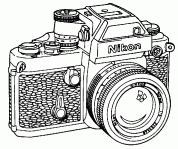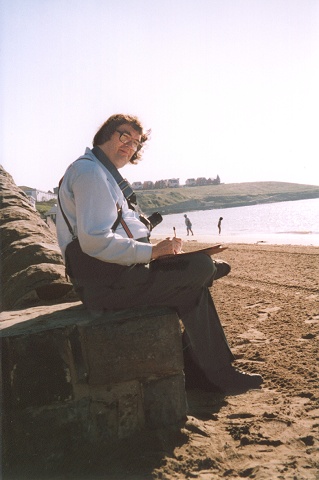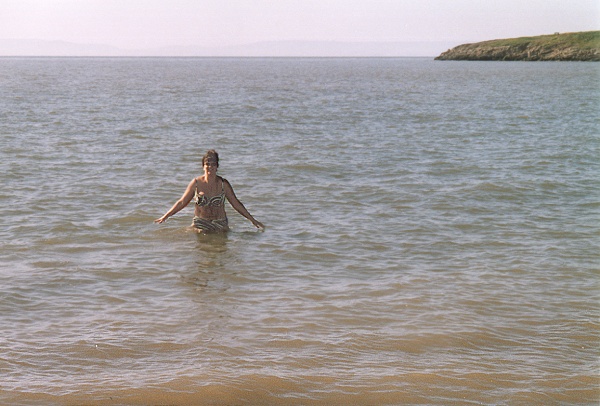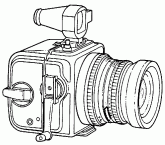|
Photograph Albums: Family
|
|
Babies:
|
Responsibility, emotions and a new experience are expressed.
|
They are also a beginning, anticipating photographs to come in years to come and you look for tell tale features if the picture is close enough (like big feet).
|
|
Mother and baby:
|
Well imaged in religious art, and father holds the camera.
|
Certain activities like breastfeeding are rarely shown.
|
|
Father and baby:
|
A playmate amusing the baby; sometimes parenting exists as property.
|
The photograph can show proudness, role reversal or equality, however.
|
|
That's typical:
|
Acting up or shyly to being photographed (with power relations) and roles being played out to camera.
|
It means that acting up is typical of *** (father, in my experience) to do that rather than what is actually typical; it is also awareness of changing the moment to avoid the mundanity of other times.
|
|
Rites of passage:
|
Events of going through the social world.
|
They are stuffy but what I do is walk around and focus on quirky goings on and when I was photographed with PhD gown it was given to me by the photographer and I never even hired one or walked around in one.
|
|
Important possessions:
|
Toys and, later, cars and houses - objects that describe us but also insurance.
|
I have photographed my Amstrad 8256 computer that produced my PhD.
|
|
Child and bike:
|
Independence and achievement.
|
I have been so photographed on a tricycle.
|
|
Adult with car:
|
A rite or passage and social status.
|
In my case it is that I drive each car not own it, but I also like the car in landscape and someone in it (might add achievement too, passing the driving test).
|
|
House:
|
Also achievement as well as frame of activity, context of event and insurance; and there is the view out showing place.
|
It is also about how the immediate environment changes - a new fence, change of porch and windows.
|
|
Meals:
|
Belonging and shows the family in power relationship.
|
I have photographed friends at meals arranged by and featuring Elena.
|
|
Hobbies:
|
Being involved, successes and failures.
|
This included for me activity at the art class combined with Elena modelling.
|
|
Dressing up:
|
Fun, hobby and work put in.
|
I have been photographed in a home made and fully used religious gown. Elena sometimes likes a new outfit to be worn for a photograph.
|
|
Official photos:
|
Encounters with institutions.
|
School of course and at the back due to height.
|
|
Sibling games:
|
Represents a more innocent time but children do photographic play acting for the camera.
|
This included a trip to the play park.
|
|
Spouse:
|
Very edited and previous spouses tend to disappear, the new spouse is photographed heavily alone until children come along, and the father is the photographer, and later spouses appear in front of landmarks.
|
In my case there was Elena's visit and then many, tailing off a little but she enjoys photography at both sides of the camera, being in (often duplicate) pictures to send home.
|
|
Grandchildren:
|
They are still a big subject of interest despite parents themselves having the income to photograph at will.
|
Mum kept a record of granddaughter and great granddaughter but I actually do the photography and perhaps take fewer than I might.
|
|
Girlfriend/ Boyfriend:
|
The photograph is part of the act of looking and the courtship, and often shows embarassment as the photograph carries presentation beyond control.
|
All along photographs have been important, but previous relationships have not been censored out although they have no wider circulation.
|
|
Friends:
|
They can come to dominate in the photography of adolescence in holiday and leisure settings, the different faces reducing as time goes on.
|
They are still important from time to time, and grew in importance with Elena coming to the UK - however, they represent the few friends in over relaxed circumstances and may give a false impression of what they do.
|
|
Peer group:
|
These are faces of the extended or surrogate families through which we move.
|
The photographs tend to be limited to a few friends.
|
|
Visitor:
|
He or she may take the photograph with a greater acting up for the camera or becomes presentable.
|
Very rare.
|
|
Sex:
|
The partner is photographed in a sexy manner, but beyond the photo shop the viewing numbers often stay confined to the partners and show themselves how they were when viewed in later life.
|
The photo shop and reserve is its own restriction, as is sex as a special wholly private event.
|
|
Pets:
|
They are often photographed with children and show the important relationship, and a pet can be surrogate offspring held by a woman.
|
I took hundreds of dog pictures, and in the end they provided a biographical survey, the last pictures of Jenny receiving special mounting in a photograph album.
|
|
Acting the fool:
|
This is partly due to being unable to decide how to pose, as a pose takes place when the camera is raised, so there is an anti-pose or even protecting individuality behind the tomfoolery.
|
Rare and irritating when it has happened.
|
|
Agility and strength:
|
People display physical skills and sporting celebrations, and likely covering up vulnerability.
|
It has been limited to children.
|
|
Photograph Albums: Christmas.
|
|
Women:
|
They get involved in buying the film and taking the pictures and organising others to take pictures.
|
Elena is very keen to capture Christmas events of the day.
|
|
Presents:
|
These are records of exchange binding the family unit, and opening presents puts on the smiles of family life, and again so much of the darker side is unstated.
|
The adult also is allowed through the photographing to participate in the child-like event.
|
|
Santa:
|
Such photographs were popular but have declined.
|
Never done.
|
|
Parties:
|
Photography brings everyone into the event and even its act organises the party whilst the result retells the event afterwards.
|
They also provide a sexiness of snap.
|
|
Photograph Albums: Holidays.
|
|
Window:
|
A view from it shows arrival and holiday space.
|
Usually the photographis of the accommodation and the view is only taken if it is interesting.
|
|
New landscape:
|
The view confirms being away and prove travel, and someone in front shows proof of involvement.
|
The photographs are like marker posts, but each group needs to be varied from the last, the group consisting of often looking both ways and along a road.
|
|
New buildings:
|
An interesting building tells of involvement again, but also the difference between those who live there and ourselves as well as differences and similarities between holiday space and home space.
|
The building does have to be interesting, or more usually the group of buildings in terms of architectural style and local building material.
|
|
New social groups:
|
Holiday friends are new people that can be photographed in activities or in front of new buildings and landscapes.
|
Very rare, but more likely is the other person persuaded to photograph Elena and me as a couple (selected on the assumption that they will not run off with the camera).
|
|
Tour guides:
|
Likeable and attractive tour guides are photographed, and mainly women in situation not refusing to pose because they are in the situation of employment carrying out a role, and in addition they may be local representing the holiday space (similarity and difference).
|
I have never done this.
|
|
Picnic:
|
This situtation brings together nature, leisure and the meal whilst being interaction in holiday space.
|
An alternative is the picture of eating an icecream which suggests younger innocence and messy eating.
|
|
Local pastimes:
|
We photograph what we used to do when we see something similar later in life and we collect images of interest to outsiders (almost that this is their holiday space).
|
I have photographed the act of painting - they are interesting "doing" pictures.
|
|
Seaside deckchair:
|
A "we are here" pose, an easy and passive shot of journey's destination rather like the window shot.
|
Mine showed people doing what they should not have been doing.
|
|
Seaside promenade:
|
We walk along it and are pictured on this other icon of the seaside, once the practice of the dubiously professional seaside photographer.
|
Mine showed the oddness of the family characters who had collected along the promenade.
|
|
Camping and caravaning:
|
Another form of window picture, this is (in camping) the low budget end and holiday space for a range of holiday type photographs.
|
Never done it.
|
|
Boat trips:
|
Sightseeing and unusual means of transport in the holiday setting where the object of transport is a subject in itself.
|
There was a sense of isolation and danger rowing out into the sea, an event with friends on a summer evening trip that gets retold in ever more elaborate terms.
|
|
Characters:
|
Other holiday makers or a local person can feature in the holiday album display, the local peson being the harder to approach and is therefore the generally willing and in employment person not likely to refuse.
|
I would like to be like Sutcliffe but these days local people lack distinctive costume.
|
|
On outings:
|
We picture stops and the destinations (not movement) on these intensive trips and photographs hide the fact that often a place is only stopped in for a few minutes.
|
The photograph is compensation for the shortness of stay - but in fact I have photographed scenery from a traffic queue (the Cob, Porthmadog) and as a passenger photographed the M62.
|
|
Sites/ attractions:
|
These are special tourist experiences and the photograph is a recognition of our understanding this which then transfers second hand to the viewer of the album.
|
There was this simulcra of scenes within Blackpool Pleasure Beach on the one visit.
|
|
Photograph Albums: Weddings.
|
|
Proof:
|
The professional is still required to do the offical record but others add to them with repetition or following family and outing venaculars.
|
I wanted to photograph my own wedding which did not have an official photographer when others seemed to be making a hash of it.
|
|
Exit from church:
|
A formal structure of participants in the photograph is made in tandem with the professional and a family with tribal lineage is observed almost defining each integrated family unit.
|
The best ones were those which caught the action: someone throwing confetti looked like they were stabbing someone.
|
|
Signing the register:
|
The official photographer and others takes this setting, now able to do so and its profanity overcoming its sacred and legislative status.
|
The artificiality of this always seems to show, that the thing was signed as if long ago.
|
|
Cutting the cake:
|
Another set piece event but its secular setting made it a photographic event earlier than the register.
|
It has to be a real knife cut, best if it can be action involved.
|
|
Never seen - Funerals:
|
The funeral in this country is a taboo event for photographs as it is not a happy integrative event but represents loss, unless they have broader social significance in the public sphere, although sometimes the dead are photographed very privately.
|
It follows on from death as the unseen and unmentioned, the same as the fact that funeral directors and crematoria do what they do in a secret world.
|
|
Photograph Albums: The Environment.
|
|
In general:
|
People look for aesthetic beauty although keener amateurs look for any environmental object that provides photgraphic form.
|
The point is that the photograph is a cultural production and it is done for the end point.
|
|
Landscape:
|
This is still a cultural construction - few landscapes are natural - with a classical and romantic aesthetic within the picture clearly observed and laid out, and different from the urban.
|
I often photograph this with a painting in mind, and it may becomes a painting, but I include not exclude the urban setting. Increasingly I like a person or more in it, and fairly close, to give scale, perspective and added interest. Landscape is often dull and uninteresting so it must follow rules of movement of the eye and therefore some difference within.
|
|
Nature:
|
This also contrasts with the urban and is a representation of natural history.
|
Yet the park and golf course is itself a production and so the framing and aesthetic is an extension.
|
|
Trees:
|
These appeal to our aesthetic sense and give scale, either offering green leaves or skeletal structure with evidence of a prevailing wind and a connection with popular pantheism.
|
Trees give the vertical of the L shaped composition, and a branch horizontally above with some leaves also frames what is seen below. For me, a tree is fractal like rather than pantheistic.
|
|
Animals:
|
They are most often photographed in prepared settings like a wildlife park or zoo, and animals can either be taken as if with human attributes or for their otherness.
|
It is important that the animal is in its appropriate place.
|
|
Water:
|
It can represent being calm, rushing, clean and fresh (and similar metaphors) and activity holding (and subordinate).
|
There is also the issue of whether it is caught frozen or blurred, and whether it is its own form or produces a mirror like reflection.
|
|
Details:
|
People get close in to represent something bigger, showing information and suggesting understanding.
|
I have photographed walls close, plants close and some rural objects.
|
|
Flowers:
|
Vegetables are photographed far less than flowers, and so there is a division here between the specialist grower and general interest, and flowers are taken in situ for their symbolic meaning with the keen amateur getting in close and exploiting form and shape.
|
There is also still life with flowers or vegetables arranged.
|
 This is a book which takes a wide survey of amateur photography and its supports and some theoretical insight in terms of definitions into what is going on when people pursue this activity. This is media studies, cultural studies and draws on sociology and psychology. The book comes from academic writing, and is itself a reflection that there might be a wider market in the subject especially for the more serious and dedicated amateur photographer. The basis of the work is that there is far more to the activity than just picking up a camera and shooting: there is the norm of camera use, context and expectation, and what to do with photographs when we have them.
This is a book which takes a wide survey of amateur photography and its supports and some theoretical insight in terms of definitions into what is going on when people pursue this activity. This is media studies, cultural studies and draws on sociology and psychology. The book comes from academic writing, and is itself a reflection that there might be a wider market in the subject especially for the more serious and dedicated amateur photographer. The basis of the work is that there is far more to the activity than just picking up a camera and shooting: there is the norm of camera use, context and expectation, and what to do with photographs when we have them.

 After this comes the quickly dated chapter on photography now 88-96). Since the publishing date of 1992 photography has changed a great deal, although the history remains similar of course, and an electronic future was seen. There are other aspects too, such as people moving up and down the camera quality range and sociology/ culture of the picture taking (which repeats some points made in the venacular table above, such as happy families and rites of passage). Here it predicts official photography will stay in existence, but amateur phtography continues ever more to select the positive side of family life.
After this comes the quickly dated chapter on photography now 88-96). Since the publishing date of 1992 photography has changed a great deal, although the history remains similar of course, and an electronic future was seen. There are other aspects too, such as people moving up and down the camera quality range and sociology/ culture of the picture taking (which repeats some points made in the venacular table above, such as happy families and rites of passage). Here it predicts official photography will stay in existence, but amateur phtography continues ever more to select the positive side of family life.